Kathy Cloutier realized there was a desperate need for high quality child care in Rhode Island but as the executive director of a busy refugee settlement services agency in Providence, she wasn’t sure just how it could all come together. Then a nearby child care program closed its doors and was looking for a non-profit to accept a donation of assets.
“They gave us money and classroom furnishings – all of which was fantastic – but all I could think of was ‘now what do we do.’”
Cloutier reached out to LISC Rhode Island for help navigating the challenge. Local Initiatives Support Corporation (LISC) manages the Rhode Island Child Care and Early Learning Facilities Fund (RICCELFF), a public/private partnership designed to help child care and early learning programs develop safe, high-quality learning environments. The LISC team provides technical assistance and financing to child care providers looking to expand or improve their facilities.
Cloutier, Executive Director of Dorcas International Institute, had been dreaming for a long time about ways to repurpose some existing space in their Providence facility and felt challenged by the scope of the project. Dorcas provides education and training to more than 200 people each year — including courses in English, GED prep, basic carpentry, computer literacy, driver training, and others, along with employment counseling, a workplace clothing collaborative, crisis counseling, citizen and immigration counseling, and translation and interpretation services in more than 60 languages.
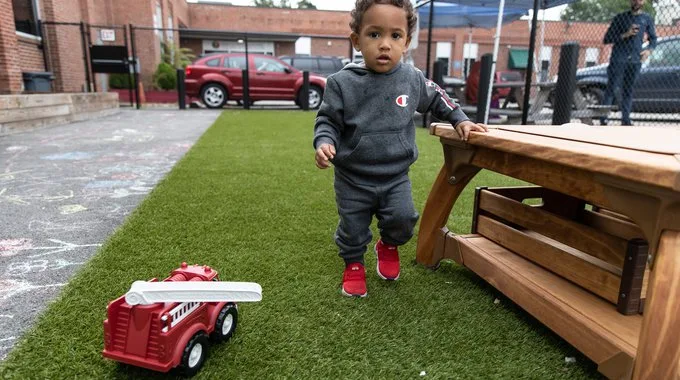
The LISC child care team not only provides financing solutions and planning grants, but also substantial technical assistance needed to navigate licensing requirements, architectural planning, and financing that delivers safe, high-quality child care spaces. The team is led by Erin Cox, AIA, Megan Ressler and Nati Taveras, and is supported by Rhode Island staff and a network of LISC’s national program teams in Child Care, Education and Lending.
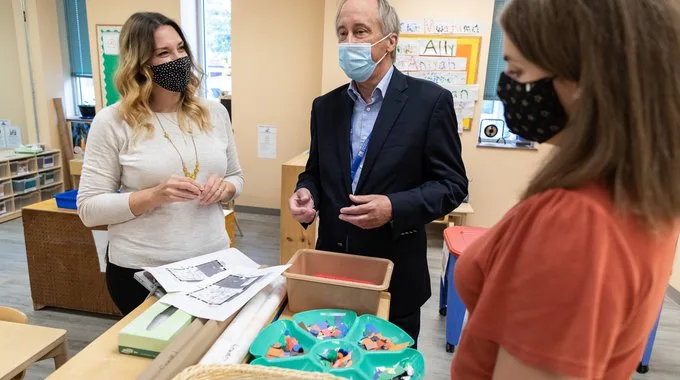
“Providers understand running child care facilities, but not necessarily the licensing and building requirements that go into one,” said Cox. “They’re focused on staffing, curriculum, and doing what they do best – caring for children. Unless you’re immersed in regulations and building codes, the process can be overwhelming, and it’s easy to make mistakes.”
Issues as simple as minimum square footage requires a complex understanding of licensing requirements and design considerations. LISC is not a regulating agency, but understands both best practices for child care space design and Department of Human Services (DHS) child care licensing requirements.
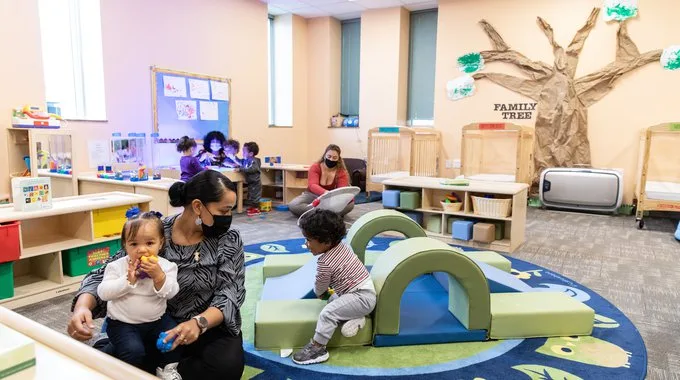
“For example, if you have 12 kids, you need a minimum of 540 square feet of usable area. The first thing you do is look at the space you have and start planning the requirements and zones of the room. Anything not intended for use by children as part of classroom activity – closets, teacher desks, handwashing stations – those fixtures are deleted from the total useable area calculations,” says Cox. “The age of the children factors into the equation as well. In an infant room, the maximum number is eight; for toddlers, that number goes up to 12. If it’s a State Pre-K program for 4- and 5-year-olds, the maximum number is 18. There are a lot of considerations, and each space looks a little different.”
Planning also considers best practices for space design. Regulations require a minimum of 35 sq. ft. of useable space per preschool-aged child, or 45 sq. ft. per child for infant and toddler classrooms, but best practices call for at least 50 sq. ft. per child. “Space is important,” says Cox, “it’s a complicated story to tell succinctly, and if the nuances are not considered, then the impact over time and future growth could be huge.”
The team will meet with providers in order to get an understanding of their plans and long-term vision for the space. They work with the facility to assess feasibility — from both a business success model and a child care delivery perspective.
“You can’t have a physical improvement of the space if the underlying business model is not sustainable,” said Megan Ressler, “they go hand in hand.” Ressler developed an interactive tool to help providers look at their business model and calculate cash flow in light of the project scope. “For many providers, they don’t think of themselves a business owner first – they’re in this to help the children, but having a clear understanding of the business helps deliver quality learning for the children.”
Technical assistance includes training to strengthen business practices, including understanding financial statements and human resource policies. LISC guides providers to ensure the strict compliance regulations are met and reflect best practices. The child care team frequently conducts guest lectures through Rhode Island College, Community College of Rhode Island, and Center for Early Learning Professionals as well as offer trainings geared specifically to architects working in this field.
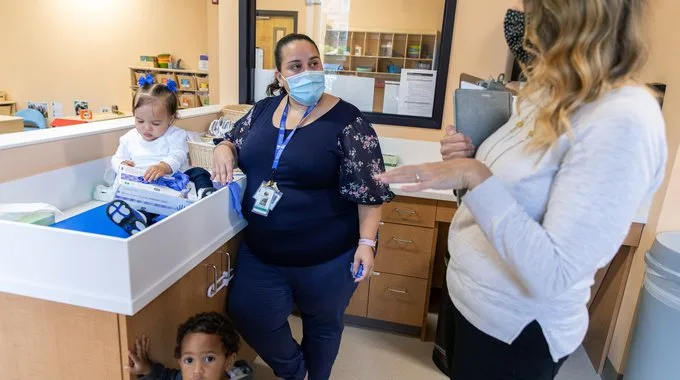
For program delivery at Dorcas, the center partnered with Children’s Friend, a child care provider with more than 13 sites in Providence, Pawtucket and Central Falls. Children’s Friend provides a broad offering of prevention and intervention services for children and families including adoption, foster care, early intervention, and nurse-family visiting for high-risk newborns.
“The key to everything we do is to provide an engaging, high-quality learning environment that’s central to achieving good outcomes in children – as well as central in attracting and retaining staff,” said David Caprio, President and CEO of Children’s Friend. “The technical assistance we’ve received from LISC has been essential, especially in rebuilds like at Dorcas. Meeting the DHS requirements is very challenging, but LISC is able to work with our staff and the architects to develop space where both kids and staff really benefit.
“We’re fortunate in Providence to have a fairly tight community where people have worked together for years, it’s made a big difference to our growth,” said Caprio. “LISC doesn’t provide 100% of the answers, but the importance of the conversation – and the questions that come up as a result – can’t be overstated.”
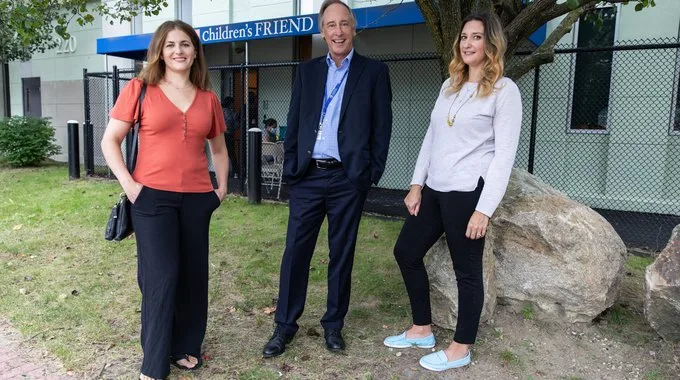 Program Officer Megan Ressler (left) and Senior Program Officer Erin Cox stand with Owen Heleen, Director of Program Development and Innovation at Children’s Friend in front of the child care program at Dorcas International in Providence, RI.
Program Officer Megan Ressler (left) and Senior Program Officer Erin Cox stand with Owen Heleen, Director of Program Development and Innovation at Children’s Friend in front of the child care program at Dorcas International in Providence, RI.LISC’s technical assistance is not limited to interior classrooms or large providers. Technical assistance is also valuable when considering outside space or smaller programs.
“We provide significant TA [technical assistance] to groups that we’ve worked with for a long time, but also to other people who have questions but don’t know where to start,” said Cox. “For this category of provider, we’ve created an application that helps us start with a baseline about their program and what they’re considering. We offer a free resource that helps them think through at least the beginning stages of a project and whether there’s funding available.”
Emma’s Home Day Care, a home-based child care program, wanted to improve its outside play area and applied to LISC for a facility improvement grant provided through an award by the City of Providence. This grant program provided funding for indoor or outdoor improvements or expansions and priority was given to applications that would bring centers into compliance with existing child care regulations or remediating areas that may have posed risks to children’s health and safety.
“Emma’s Home Day Care is a perfect example of a small provider who benefited from technical assistance,” said Nati Taveras, Program Assistant for LISC’s Child Care and Early Learning Facilities Fund. “This was a situation where we had a lovely woman with a child care program in her home and was looking to improve the outdoor play space. She applied through the grant program, but really didn’t know how to get started.”
The team at LISC conducted a site visit and provided a list of suggestions and recommendations for contractors that would move the project forward. Emma contacted John LaRue of J.P. LaRue, Inc., a playground design and construction company based in Little Compton, RI., to manage the new construction.
“We were able to identify several safety issues that could be addressed within the scope of the grant,” says Taveras. “And worked with an established playground safety inspector to put together a work plan.”
The project involved changing the grade of the yard, raising a shed and installing a fence and proper ground cover. The impact of this effort was huge.
“Technical Assistance can go in several different directions,” said LaRue. “There are very strict safety guidelines that we need to follow — whether it’s for public, home-based or state run centers. The LISC team has a good understanding of the safety regulations — both in terms of the ADA (American Disability Act) requirements, as well as the age appropriateness of play equipment. You don’t want 5 year olds playing on equipment that’s designed for a child that’s 6 months old. Play value is critical.”
The project at Emma’s presented a number of challenges — including language differences — but it was completed quickly and on budget. Having a fully bi-lingual team allowed confidence that more complicated issues were fully communicated.
“Because LISC has an understanding of safety, accessibility and liability concerns, it’s very easy to present a plan and work order that will address these key issues,” said LaRue. “When you’re dealing with people who know their stuff, it makes your job easier.”
According to Taveras, it all hinges on relationship building. “Sometimes it’s just a matter of having a conversation with the provider to let them know that we want them to be successful and that we’re here to provide the tools and resources to help them achieve that success.”
###
